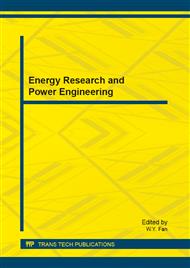[1]
G. Andersson et al., Causes of the 2003 major grid blackouts in North America and Europe, and recommended means to improve system dynamic performance, IEEE Trans. Power Systems, vol. 20, is. 4, Nov. 2005, p.1922-(1928).
DOI: 10.1109/tpwrs.2005.857942
Google Scholar
[2]
H. Harano, K. Syutou, T. Ikesue and S. Kawabe, The development of the Manipulator method for 20kV class overhead distribution system, Transmission and Distribution Conference and Exhibition, 6, 2002, pp.2112-2116.
DOI: 10.1109/tdc.2002.1177787
Google Scholar
[3]
R. Ishino and F. Tsutsumi, Detection System of Damaged Cables Using Video Obtained from an Aerial Inspection of Transmission Lines, IEEE Power Engineering Society General Meeting, 2, 2004, pp.1857-1862.
DOI: 10.1109/pes.2004.1373201
Google Scholar
[4]
I. Golightly and D. Jones, Visual control of an unmanned aerial vehicle for power line inspection", Proc. IEEE Int, l Conference on Advanced Robotics, 2005, pp.288-295.
DOI: 10.1109/icar.2005.1507426
Google Scholar
[5]
R. Electronic Publication: Digital Object Identifiers (DOIs): Article in a journal.
Google Scholar
[6]
H. Goto, Y. Hasegawa, and M. Tanaka, Efficient Scheduling Focusing on the Duality of MPL Representatives, Proc. ASME Symp. Computational Intelligence in Scheduling (SCIS 07), ASME Press, Dec. 2007, pp.57-64, doi: 10. 1109/SCIS. 2007. 357670.
DOI: 10.1109/scis.2007.367670
Google Scholar
[7]
D. Kornack and P. Rakic, Cell Proliferation without Neurogenesis in Adult Primate Neocortex, Science, vol. 294, Dec. 2001, pp.2127-2130, doi: 10. 1126/science. 1065467. Article in a conference proceedings.
DOI: 10.1126/science.1065467
Google Scholar
[8]
Becker, M., Landre, J. and Santos S. C., 2006, Design of Mechatronics Systems to Inspect Power Transmission Lines and Towers, Proceedings of the 2006 International Symposium on Power Electronics.
DOI: 10.1109/speedam.2006.1649874
Google Scholar
[9]
Rocha, J. and Sequeira, J., 2004, The development of a robotic system for maintenance and inspection of power lines, Proceedings of the 35th International Symposium on Robotics, Paris, ISR (2004).
Google Scholar
[10]
Nayyerloo, M. et al, 2007, Mechanical Implementation and Simulation of Monolab, a Mobile Robot for Inspection of Power Transmission Lines, International Journal of Advanced Robotic Systems, Vol. 4, No. 3.
DOI: 10.5772/5676
Google Scholar
[11]
Xiao, X.H., Wu, G., and Li, S., 2007, Dynamic Coupling Simulation of a Power Transmission Line Inspection Robot with its Flexible Moving Path when Overcoming Obstacles, 3rd Annual IEEE Conference on Automation Science and Engineering, Sept. 22-25 2007, Scottsdale, AZ, USA.
DOI: 10.1109/coase.2007.4341691
Google Scholar
[12]
Sawada, J. et al., 1991 A Mobile Robot for Inspection of Power Transmission Lines, 1991, IEEE Transactions on Power Delivery, Vol. 6, No. 1, pp.309-315.
DOI: 10.1109/61.103753
Google Scholar


